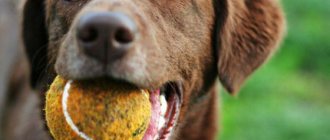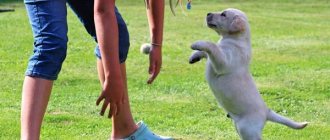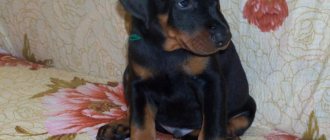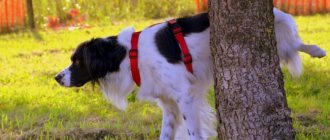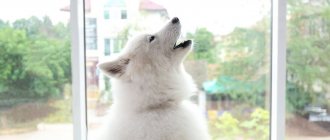The holiday of disobedience and its reasons
Dog breeders are often faced with the fact that the pet follows commands on the training ground, but ignores them outside of it. To understand why an animal behaves this way, you need to understand the reasons.
Reasons for disobedience in dogs:
- breed predisposition;
- rough treatment;
- dominant character;
- spoiled;
- improper socialization, adaptation;
- errors in training, unsystematic training;
- mobile psyche, excessive emotionality.
Problems with disciplining a pet that has reached puberty arise due to the fact that we do not always correctly understand the signs and emotions of animals. The dog may not obey, experiencing pain, discomfort, due to deterioration in health, after suffering stress, if it is afraid, or frightened by something.
Disobedience in a dog can be genetic. Wayward character, love of freedom, banal selfishness, incorrect prioritization.
If your dog often organizes a festival of disobedience, and you cannot determine the reasons for it, contact a dog handler. The specialist will find an approach to the animal and teach how to instill in the dog the correct behavioral manners.
Pekingese
Bug-eyed furry pets consider themselves superior to everyone else.
Therefore, when the owner gives a command, the dog believes that it is not addressed to it. Pekingese do not like the company of children. They would rather spend time with their owner on the couch watching videos. Pekingese adore their owner and follow him on his heels. However, attempts to teach commands to a pet cause genuine resentment among Pekingese. We also recommend reading:
The largest dog breeds What is domestication in animal husbandry Why you should get a cat: reasons voiced by scientists Euthanasia of animals
Bugle-eyed animals are capricious for a long time; you can beg for forgiveness with the help of treats. Pekingese are calm, but at the same time proud and stubborn. They are loved not for their submission, but for their kindness and attractive appearance.
The most naughty dog breeds
Based on statistical data and numerous studies, Columbia University psychology professor S. Koren compiled a rating of dog breeds in order of their trainability.
The most naughty dog breeds:
- Basset Hound. This medium-sized dog breed is known for its unusual appearance, sad eyes, and huge, drooping ears. Bassets have a well-developed hunting instinct and a keen sense of smell. Despite its inherent intelligence, the Basset Hound has its own ideas about training and education. The owner can spend hours teaching his pet basic commands. If the dog doesn't want to do something, you won't get anything from him.
- Beagle. One of the ancient dog breeds. This is not to say that beagles are stupid and poorly trained, these dogs are simply stubborn and independent. They are incredibly loyal to their owners and require increased attention from their owners.
- Pekingese. Despite its small size, this breed is distinguished by its independent, willful, and domineering character. These dogs are stubborn and refuse to do anything they don't want to do. You should not demand the impossible from the Pekingese, trying to teach him complex commands. Still, this is a decorative dog breed that is very loyal to its owners.
- Mastiff. Despite their good-natured disposition, although these large dogs are endowed with intelligence, they differ from other breeds in their stubbornness and often show disobedience. Without experience, entrust your pet's training to a dog trainer.
- Bloodhound. Experts involved in dog training unanimously note that this breed is naturally endowed with a wayward, stubborn disposition. Bloodhounds can be considered a mystery breed. They have an excellent sense of smell, follow the scent, recognizing the subtlest odors, but show stubbornness when learning and following commands.
- Russian greyhound. A freedom-loving breed with a soft “cat-like” character. Dogs are active, curious, cheerful, but disobedient.
- Chow-chow. These dogs often behave the way they want. They are like cats that walk on their own. The dog understands what the owner requires of him, but often shows disobedience due to his innate stubbornness.
- Bulldogs. This breed seems to feel its aristocratic origin. These dogs were kept in the courts of noble people. Bulldogs are pampered, wayward, but very loyal pets. Doggies often change their mood. Training requires patience and must be systematic.
- Basenji. A rare and not very popular breed of dog. Dogs are active, inquisitive, independent, and spend a lot of time caring for themselves. Learning commands will require patience from the owner.
- Afghan Hound. In ancient times, these dogs were kept at the courts of Egyptian emperors and pharaohs. Involved in the hunt. Afghans are endowed with intelligence, but if they are fascinated by something, do not expect submission or obedience from your pet.
The rating given should not influence the choice of breed. Each animal is unique. And if a dog is not very trainable, this does not mean that he is devoid of gray matter.
It is not necessary for your pet to know all the commands. It is enough to instill the necessary skills and teach basic commands.
Chow chow
Similar to clumsy bear cubs, these dogs have a good disposition and are calm. Among the negative qualities is stubbornness, which prevents these smart dogs from learning to follow their owner’s commands. Many believe that this is due to low mental abilities. Veterinarians say that the chow chow’s obstinate nature is to blame. There are examples where the owner’s patience contributed to the pet achieving high results in training.
What not to do - the main mistakes of novice breeders
If a dog does not obey the owner, does not respond to prohibitions, or behaves inappropriately on the street, the owners are often to blame for such pet behavior.
What not to do - the main mistakes of novice breeders:
- Encouraging your pet to misbehave. You can't follow the dog's lead. A dog who does whatever he wants will feel like a dominant leader. And this cannot be allowed. From puppyhood, the dog must understand what is allowed to do and what is not.
- The dog should not sleep on the bed or chairs. In nature, only the leaders can rest at higher elevations.
- Do not allow your dog to show aggression towards household members or strangers. Immediately stop attempts at such behavior.
- Feed the dog only after you and the whole family have eaten. During lunch and dinner, it is best to kick your pet out of the kitchen. Don't give treats from your table.
- Not a properly organized training system. If a dog handler is working with a dog, the owners must systematically practice and consolidate the skills acquired on the training ground. Choose different places to study.
- Teaching a dog several commands at the same time. Training must be consistent. Only after the dog has memorized one command well, start teaching others.
- Do not adapt to the dog, do not make concessions during training. Always get your dog to complete the task to the end.
- Frequent repetition of the command. The command must be given only once with strict intonation. Otherwise, the dog will do it when it sees fit.
- Same intonation for reward and punishment. Dogs may not understand human language, but they are great at picking up intonations and feeling our emotions.
- Lack of adequate punishment. If a dog bites, shows aggression, turns the apartment upside down in the absence of the owners, the dog must be punished and this must be done while committing the offense. This does not mean that the animal should be beaten. Physical violence is unacceptable. Shout at the dog, lightly slap him on the rump, pull the leash. The ideal punishment is lack of attention from the owner.
Alabai
Central Asian Shepherds are excellent guards. No stranger or unfamiliar animal will pass by them. Their ancestors guarded the pastures where they grazed livestock. Alabais are not prone to active pastime. They prefer to be in “energy saving” mode. Of all the family members, one is chosen, who is considered the leader. In the presence of the owner, these dogs behave like exemplary pets.
As soon as the person who has been torn out as leader leaves, the dog takes over the rights of leader. At the slightest threat, Alabai are able to rush to the defense of the owner and all family members. Alabai attack without warning. It is almost impossible to raise an obedient representative of this breed.
Choosing a collar for a rowdy
A leash, muzzle, and collar are indispensable attributes for walking and training dogs. The choice of collar depends on the breed, size, character traits, and temperament of the dog. Pay attention to the quality parameters of the material.
Important! The collar should be comfortable for the dog and fit in size.
- For disobedient medium and large dogs, wide canvas, leather collars, leatherette collars with durable fasteners and a welded steel ring are suitable for daily walks. The ring should be removed from the clasp.
- For small dogs - walking harness, strap models made of elastic soft leather.
- For training, practicing commands, and correcting behavior, purchase a strict collar (parfos), a choke collar or half-choke, in which the loop is not fully tightened around the dog’s neck. Choke collars are made of fabric materials, leather, metal (snatch chains). Half-chokes can be made from a combination of leather and metal.
Beagle
Funny, mischievous and cheerful dogs. Throughout their lives they behave like little, ignorant children. In fact, they are not stupid, but simply overly active and playful puppies. In order for the house in which the beagle lives to remain safe and sound, you need to walk and play with the dog a lot. They are incorrigibly curious, ready to stick their cunning nose anywhere. This trait of their character causes a lot of trouble.
Correcting puppy behavior
Correcting a puppy’s behavior involves a set of measures that will help eliminate unwanted behavioral skills in the pet. In essence, this is the education of animals, based on the use of praise, encouragement, and punishment.
Important! Education, unlike training, is a more complex, time-consuming process. With the right systematic approach, you can raise not only an obedient, controllable dog, but also a loyal friend and companion.
Behavior correction is necessary:
- For hyperactive, overly excitable puppies, dogs with an active psyche.
- If the puppy shows aggression towards people, family members, relatives, animals.
- If the dog is not properly socialized.
- If a puppy has fears, phobias, he behaves inappropriately when exposed to strong stimuli. For example, the dog is afraid of other dogs, cars, fireworks, loud noises.
- The puppy has destructive (destructive) behavior. The dog chews furniture and turns over the apartment in the absence of the owners.
- In case of uncleanliness of the dog, if the puppy craps in the house.
Shih Tzu
These furry babies attract the attention of adults and children at first sight. The breed was created by breeding the most attractive small dog, which will delight with its appearance. The homeland of Shih Tzu is China. In this country, these dogs were intended to be kept by members of the aristocracy.
The manifestation of eccentricity and whims was characteristic of the owners of decorative dogs, so it was not intended to train these cute creatures. Despite their reluctance to obey the will of their owner, Shih Tzus never show aggression.
Methods for raising an adult disobedient dog
If you missed the opportunity to raise a puppy or you adopted an adult dog from a shelter, we will consider the basic methods of raising an adult disobedient dog.
The training system is selected individually for each individual. Takes into account the age, breed, character of the dog. There are no identical templates. There are dogs with a soft, flexible character, for whom a harsh intonation is enough, there are stubborn, wayward pets that require a tougher approach to education.
Methods and rules for raising disobedient dogs:
- Consistency in learning based on rewards, punishment, and reprimand. Praise the dog for correct actions, and for misdeeds - adequate punishment without the use of physical force.
- The owner must be persistent and unwavering in his actions. Give the command once, ensuring its execution.
- Use different ways of learning. Some useful skills can be instilled during the game.
- Systematic training. Constantly reinforce the correct command skills your dog has learned. Regular classes contribute to the accurate acquisition of useful skills.
- Make activities interesting for your dog. Lessons should be varied. Monotonous training will not give the desired result, especially if your dog is endowed with a stubborn, wayward character.
- Start training at home. Train your pet to perform basic commands, then start practicing them on the street.
- If the dog behaves poorly at home, before leaving, give the dog a good walk and leave him toys. Protect your dog from stress and other factors that negatively affect the psyche.
- You need to scold the dog at the moment of committing an offense.
Advice! The dog should see you as a leader. Stop any signs of dominant behavior.
Correcting the behavior of an adult dog can take 10-13 months.
Mastiff
Beautiful powerful dogs have representatives of fighting and guard dogs among their ancestors. During the selection process, individuals with the most pronounced physical abilities, hardiness and fearlessness were selected. A dog performing in the fighting ring does not need the ability to obey, so mastiffs do not shine with intelligence. However, modern representatives of the breed are good-natured and calm. They are unsurpassed guards, protectors and companions.
How to properly punish a dog
Punishment is one of the effective methods used for educational purposes, in teaching and training. However, not everyone knows how to properly punish a dog. For example, strict intonation and a stern look are enough for impressionable pets, but physical punishment is unacceptable.
A rude attitude can make a dog angry. With this approach, the puppy can grow up timid and cowardly. If you constantly shout, scold, and even more so beat your dog, it will stop seeing you as an authoritative leader.
Methods of punishment:
- reprimand, strict intonation;
- jerk of the leash;
- ignoring;
- effect of surprise (loud bangs, unexpectedly flying foreign objects);
- shaking by the scruff of the neck, light slaps with a rolled-up newspaper.
Any influence on the dog due to incorrect behavior must be accompanied by prohibition commands (“fu”, “no”). Only punish your dog when you catch it in the act. Dogs do not know how to think logically and if you miss the moment, the punishment will not be effective, the dog will not understand why he was scolded or hurt.
Basenji
A feature of the rebellious nature of these comrades is their origin. This semi-wild animal comes from the African jungle. Freedom of action and the ability to move a lot and energetically are important to them. It is almost impossible to put them on a leash. In training, only encouragement and gratitude can be applied to contradictory characters, otherwise you won’t make a mess with them.
Training a naughty dog
According to dog handlers, training a disobedient dog should begin with training, mastering basic commands (“Fu”, “No”, “Next to me”, “Sit”, “Place”). Only after this can you take a special training course.
Advice! If the dog does not obey, it is useless to scold and punish him. Review the system of relationships, change the key points of the educational process.
Training rules:
- Give the command once with a clear, demanding intonation.
- Always strive to complete the assigned task.
- Use the method of reprimand and encouragement when teaching. At the first lessons, give a treat for obedience, gradually replacing treats with an affectionate tone, stroking, and praise.
- Do not overtire your dog during training, do not overload it with commands. Everything should be in moderation. The first lessons should take no more than 10-15 minutes. Be consistent in your training.
- Do not use physical force. Shouting, swearing, and beating are ineffective in training.
- Be timely in giving commands and reacting to your pet’s actions.
- Use clickers, which for many breeds are a motivator, informing the dog about the correctness of his actions. The first time after the click, give a treat. This will help form an associative connection in the animal.
- Use distraction techniques if your dog does something wrong. Learn to anticipate your pet's unwanted behavior.
- Immediately stop your dog's unwanted behavior. The dog must always respect the prohibitions.
- Gradually make the training process more difficult. Strengthen systematic skills at home, on the street in different places. You can achieve good results only after you have established a close connection and contact with your dog. Study her habits, analyze the reasons for bad behavior. Learn to understand your pet.
Basset Hound
Great melancholic and kind-hearted. He gets along well with other animals and children. Thanks to his unique sense of smell, he constantly explores new smells. This activity distracts the doggies from everything else. The Basset Hinde will willingly go for a walk and allow himself to be picked up, but he is not at all happy about training classes. His phlegmatic behavior makes his owner and trainer impatient. Poor memory and distracted attention complicate attempts to educate representatives of this breed.
